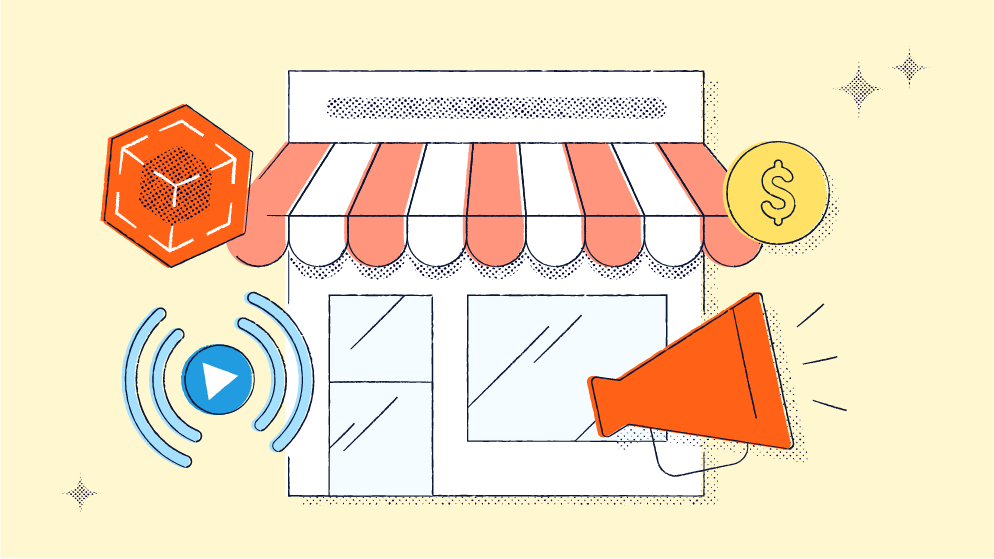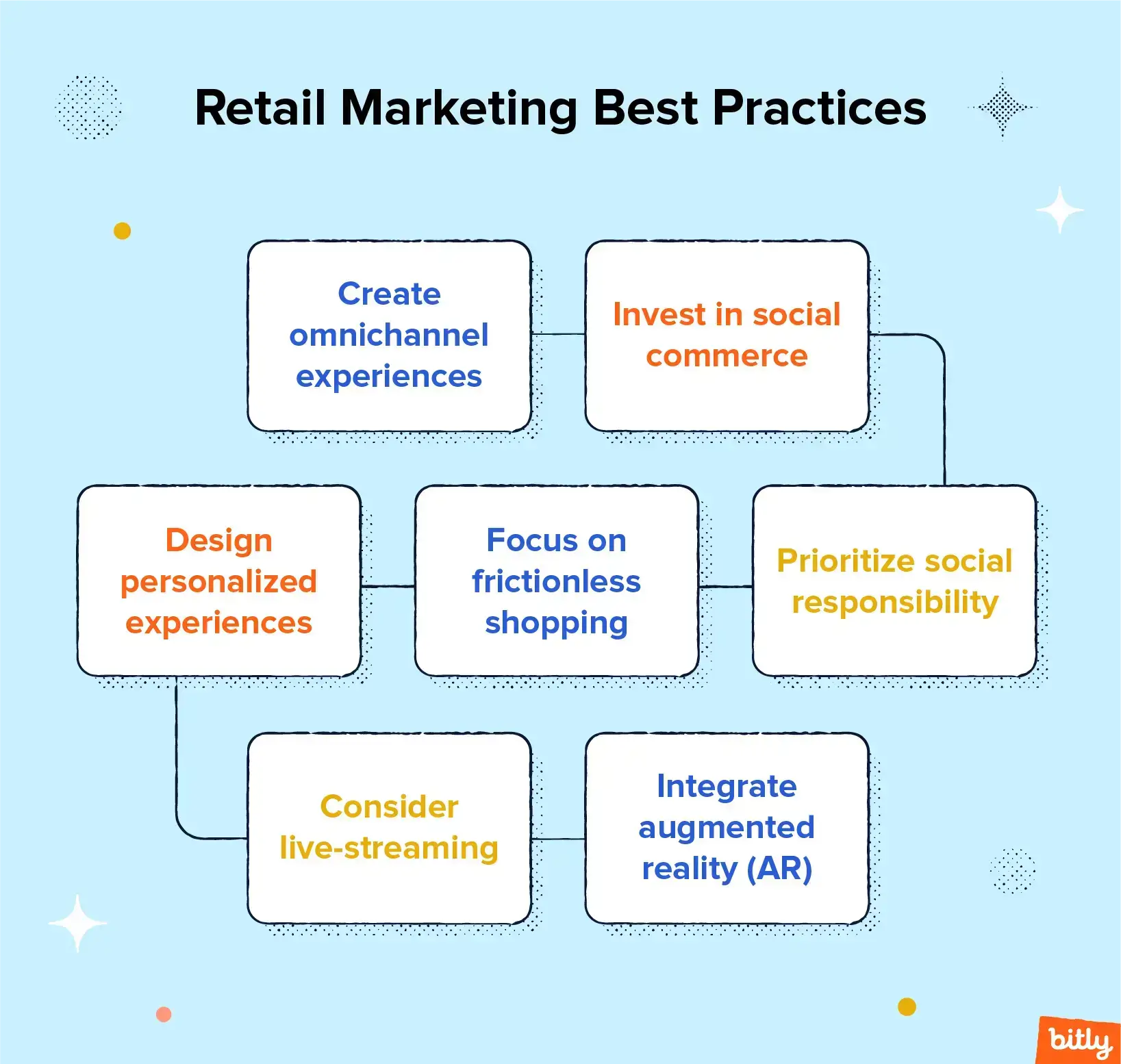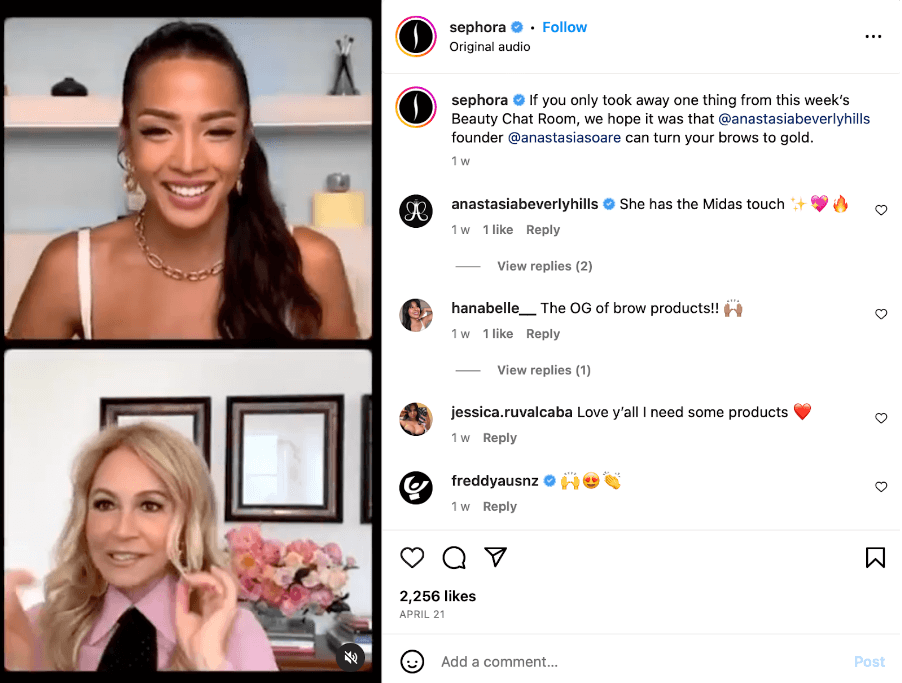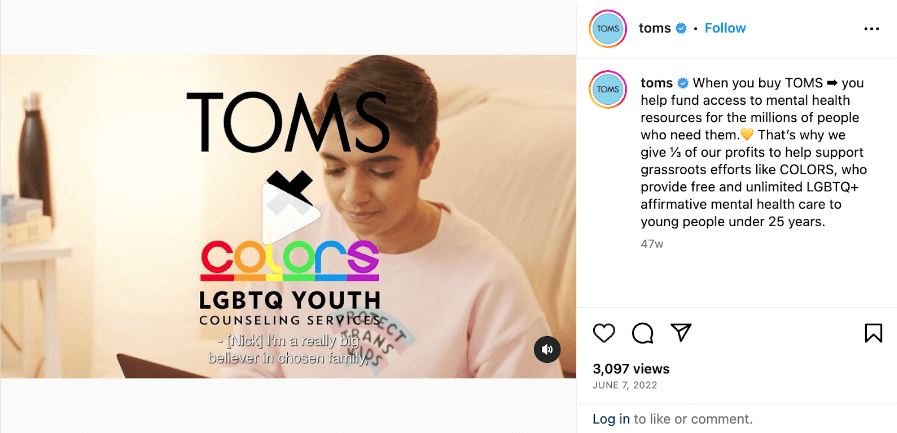
The retail industry is undergoing some massive changes. Don’t fret, there’s an upside: You have time and resources to prepare. Arm yourself with the right knowledge, and you’ll be prepared for any minor or major shift.
In this article, we cover up-to-date retail marketing best practices to help you stay agile in an ever-changing retail landscape.
What are the best practices in retail marketing?
- Create omnichannel experiences
- Invest in social commerce
- Prioritize social responsibility
- Focus on frictionless shopping
- Design personalized experiences
- Consider live-streaming
- Integrate augmented reality (AR) into retail

Monumental changes in the retail landscape
GS1 is the nonprofit organization responsible for global barcode standards. They have announced a transition from using UPC (universal product code) to 2D barcodes on product packaging. GS1 plans to support retailers in implementing this change by 2027. This shift to GS1 barcodes will have a profound impact on the retail industry—stay tuned for more updates coming soon!
Read our announcement about Bitly’s increased investment in powering connections by supporting the implementation of GS1 Standards in our products.
7 retail marketing best practices to reach your marketing goals
Here are some updated retail marketing best practices based on the latest trends. As retail marketing evolves, it’s important to prioritize these practices and allocate more of your time and resources toward them.
1. Make omnichannel experiences a priority
Given the increasing expectations and preferences of modern consumers, it is no surprise that the omnichannel trend is on a continual upward trajectory. By adopting an omnichannel strategy, retailers can provide seamless and convenient shopping experiences to customers across all platforms, whether physical or digital.
In practice, this could take various forms, such as customers browsing products on a retailer’s website or mobile app, then visiting a physical store to try out the product in person. Alternatively, it could involve a customer checking out a retailer’s social media platform, discovering a product they like, and making a purchase on the spot.
In either case, the customer interacts with the brand seamlessly and via a channel that is most convenient for them. According to Fit Small Business, 54% of consumers say they are likely to browse a product online and then purchase it in a physical store—and they are just as likely to do it the other way around, too.
Here’s a fantastic idea to enhance the customer experience in retail stores: Why not try incorporating QR Codes? Simply place them on digital signage throughout the store or even try a QR Code flyer that can be handed out to shoppers. By doing so, you provide your customers with an exciting new way to engage with your brand online via their smartphones, potentially leading to increased sales conversions.
2. Put social commerce on your agenda
Social commerce refers to the act of purchasing products directly from social platforms—and its popularity is generating a lot of buzz. The Deloitte 2023 retail industry outlook report predicts that six out of ten consumers will use social media to make purchases.
The social shopping trend has gained significant traction, and Gen Z is among the key demographics leading the charge, especially on TikTok. Remember the “TikTok made me buy it” trend that drove consumers into a frenzy? This exemplifies the power of social media platforms in shaping our purchasing decisions and revolutionizing the social commerce trend.
One thing is clear: Social commerce is part of the future of shopping. Forecasts by the Future of Commerce show that by 2027 social commerce will reach $604 billion in sales, so if you’re not thinking about it yet, you may want to adjust your retail marketing efforts toward social selling on your platforms.
Not sure which platforms to sell on? TikTok, Instagram, Facebook, and Pinterest have built-in social commerce features, making them powerhouses for social shopping. Plus, social media platforms tend to have ways to track performance, such as TikTok analytics, so you always know what’s working and what isn’t.
3. Put social responsibility front and center
Consumers these days are conscious buyers; they conduct extensive research on their purchases, making sure they align with the brand’s values and political views. Research by HubSpot shows that 50% of Gen Z’s and 40% of Millennials value companies that take a political stance on social justice topics.
One practice retailers can put in place is implementing the corporate social responsibility (CSR) principle at their companies. It’s a practice in which companies participate in a variety of initiatives that shine a light on social issues and focus on improving them both in companies and society as a whole. Examples of CSR initiatives include making diversity, equity, and inclusion (DEI) a priority at their companies, being transparent about fair trade practices, and supporting charities or nonprofit organizations.
As consumers become increasingly socially conscious, they are paying closer attention to brand transparency, ethics, and social responsibility. It’s crucial for retail brands to shift their priorities and address any unethical practices in their businesses, for the betterment of society and the planet. This will require retail brands to be more deliberate and thoughtful, but it’s also an opportunity to demonstrate that making a positive impact on society is more important than just turning a profit. By prioritizing social responsibility, retail brands have the potential to make a significant difference and leave a lasting positive impact on the world.
4. Focus on making shopping experiences more frictionless
Creating a smooth and effortless shopping experience for consumers is becoming more essential, whether they’re shopping online or in-store. To achieve this, retailers should prioritize eliminating inconvenient return policies, introducing more payment options, and providing ample customer service support.
By focusing on these areas, retailers can significantly improve the overall shopping experience for their customers, making it more seamless and hassle-free. A positive shopping experience can lead to increased customer satisfaction, loyalty, and ultimately, higher sales. Did you know that PwC found 41% of consumers value convenience and speed over affordability? It’s not that hard to imagine when we consider how busy our lives are.
Why should you make the customer experience a focus of your retail strategy? Consumers have little loyalty towards retail brands that don’t prioritize their experience and won’t hesitate to switch to companies that do. In fact, according to a recent survey conducted by PwC, 55% of respondents said they would stop buying from a company after a couple of bad experiences, regardless of whether they liked the company before.
This highlights the significant impact that customer experiences can have on customer loyalty. By prioritizing positive customer experiences, retailers have the potential to retain customers and boost customer satisfaction.
5. Design personalized experiences
Customers want to shop on their own terms and choose the channel that works best for them based on their preferences. With more brands offering more tailored experiences customers are gravitated towards these kinds of experiences.
In the PwC survey, a monumental 82% of respondents said they would share some personal data if that meant they would get more personalized service. What does this say about customers? Although customers may be concerned about their personal data, they are still willing to share it in exchange for a more curated experience. This is mutually beneficial for the retailer and customer; the customer gets the product they want and the retailer boosts sales and customer engagement.
What does personalization look like in practice? It can look like anything from sending customers product recommendations via email, personalized loyalty programs, or exclusive discounts given to customers. For example, the retailer could send product recommendations to the customer via email that is based on their purchasing history, saving the customer the time of searching for those products themselves.
6. Make livestreaming a priority
As digital and social commerce becomes more widespread, it should come as no surprise that livestreaming is on the rise. Predictions by Coresight Research show that livestream shopping sales are expected to grow to $171 billion in 2023.
Live shopping has emerged as a highly effective retail marketing strategy due to its engaging nature, direct communication between consumers and retail brands, and ability to inspire quick purchasing decisions at the touch of a button.
Live commerce offers a unique advantage in that it facilitates a two-way communication stream between customers and brand representatives during the broadcast. This creates a more immersive retail experience that enables customers to develop a deeper connection with the brand. As such, it presents a prime opportunity to engage with brand partners and influencers to represent your brand in a live event.
Whether you choose to host live events on social commerce platforms like YouTube, Instagram, and TikTok, or on your own e-commerce platform, the trend of live commerce is on the rise and presents a valuable opportunity for brands to engage with customers. So, why wait? Leverage your social media or e-commerce platform now and reap the rewards of this burgeoning trend!
Tip: Repurpose your livestream video content on your social media feed so that your followers who could not attend can still watch the video and make purchases.
7. Integrate augmented reality into shopping experiences
Many associate augmented reality (AR) with the Pokémon GO phenomenon, but its potential within the retail industry goes far beyond that. Major brands such as IKEA, Sephora, and H&M have been utilizing AR to offer customers unique retail experiences. As more and more brands continue to adopt cutting-edge AR integrations, it’s evident that a transformation is underway in the retail landscape.
AR has emerged as a popular tool in retail due to the unique and immersive customer experiences it creates. With AR, customers can engage with products in entirely new ways, creating a sense of excitement and wonder. The fact that these experiences are usually conducted with a smartphone camera makes AR a relatively easy and accessible technology for customers to enjoy.
From virtually trying on clothes or cosmetics to superimposing digital objects of furniture in customers’ homes, AR offers a wide range of experiences that not only entertains customer mid-shop but also helps them build trust in brands. Recent data from DataProt shows that a whopping 71% of customers say they would shop more if they used AR.
3 examples of brands that follow retail marketing best practices
These use cases are examples of brands that applied some of the best practices we’ve covered and knocked them out of the park.
Note: These examples were found during our online research while writing this article.
Sephora’s livestream strategy
Sephora has embraced social commerce in a big way, with their daily live beauty chats being a standout feature. Through these chats, Sephora provides its audience with exclusive beauty tips and live product demonstrations, making for an engaging and informative experience.
Sephora recently hosted a live stream featuring Anastasia Soare, the founder of the popular makeup brand, Anastasia Beverly Hills. Known as the “Eyebrow Queen,” Soare revolutionized the eyebrow product market. During the live session, Sephora demonstrated how to perfect your brows the “Anastasia way”, providing an exclusive makeup tutorial for their audience. Eager viewers could learn from the master herself, and for those who were impressed, the tutorial provided an extra nudge to purchase an Anastasia Beverly Hills eyebrow product.
The repurposed content in the Instagram post below showcases tips on how to use brow gel, sourced from Sephora’s live chat with Anastasia Soare. The content provides value to those who missed the live session and serves as a reminder for those who attended. Sephora also leveraged the “shop now” button on Instagram, making it easy for viewers to purchase Anastasia products. This approach is a great example of how to effectively utilize social commerce and livestreaming.

TOMS puts social responsibility front and center
Over the years, TOMS, the footwear apparel brand, has been committed to social responsibility, with founder Blake Mycoskie making it the core of the company’s mission. Mycoskie’s goal was to make an impact one shoe at a time, and he kick-started a new brand of social entrepreneurship called the one-for-one model, also known as “buy-one-give-one”. The idea was simple: For every pair of shoes sold, TOMS would give away one pair to support a variety of social initiatives.
TOMS recently launched a campaign in collaboration with their longstanding partner, Colors, an LGBTQAI+ youth counseling organization that provides young people under the age of 25 with free and unlimited access to mental health care. As part of this initiative, TOMS is committed to donating a third of its profits to Colors. By making a purchase, customers are not only getting a great product but also contributing to the funding of mental health services for LGBTQAI+ youth in need.

Tommy Hilfiger’s AR mirror
Tommy Hilfiger is giving the classic “mirror, mirror on the wall” a high-tech twist.
Want to try on clothes without the hassle of taking them off? Tommy Hilfiger is making it possible with their latest AR mirror initiative. Partnering with ZERO10, an AR platform for retailers, the luxury brand has installed AR mirrors in three of its stores, giving customers a chance to virtually try on clothing in real-time.
Tommy Hilfiger offered customers a unique opportunity to try on a limited-time-only 28-piece physical collection and three digital garments during the launch of the Shawn Mendes and Tommy Hilfiger capsule collection.
Despite being a pilot project to assess customer engagement with advanced technologies, this AR integration demonstrates the potential for AR to seamlessly blend into the shopping experience. Keep an eye out for more exciting developments in this space!

Boost your retail marketing with Bitly
The retail landscape is changing at the speed of light. Whether you’re just getting started with social commerce or looking to take your retail strategy to the next level with the latest technology, these retail marketing best practices can help guide you on your journey. Plus, with the Bitly Connections Platform, you have a reliable marketing parner at your side to surf through the waves of change with custom short links, QR Codes, and Bitly Link-in-bios.
Get started with a free account today and start achieving your retail marketing goals.